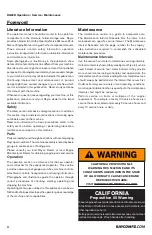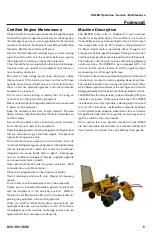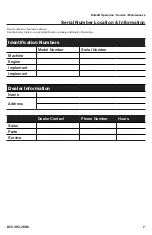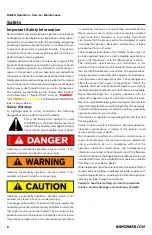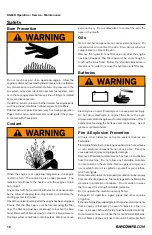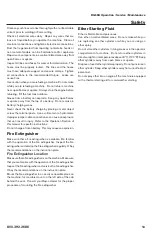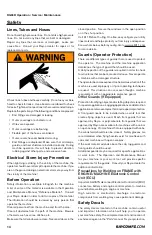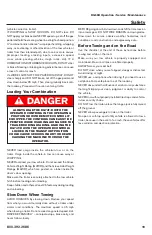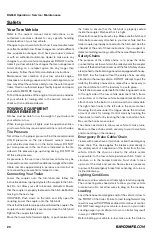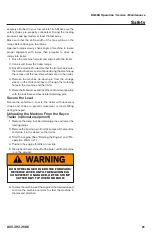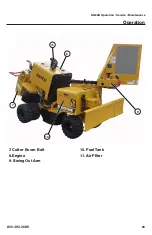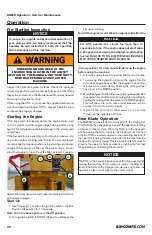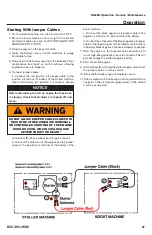
RG55R Operation • Service • Maintenance
18
Safety
condition.
3. Remove all non essential items.
4. Inform all affected personnel.
5. Check to see that all affected persons are located in
a safe position.
6. Inform the worker of the lockout/tag out removal
before the worker starts to work for his/her next shift.
7. When more than one person works on the same
equipment, multiple lock/tag outs must be used. Only
when all locks are removed can the equipment be
energized.
Removal Procedure
• Lockout/tag out equipment must be removed by the
worker who placed it.
Parking
Park on a level surface. If you must park on a grade, chock
the machine.
1. Move the joystick control slowly to the NEUTRAL position
in order to stop the machine.
2. Move the throttle control lever to the LOW IDLE position.
3. Lower all implements (if equipped) so that the work tool
implement rests firmly on the ground.
4. Move the hydraulic controls to the NEUTRAL position.
5. Turn the engine start switch key to OFF position and
remove the key.
6. Disconnect the operator restraint devices (if equipped)
and exit the machine.
While Servicing and Performing
Maintenance on the Machine
• ALWAYS Block the wheels to prevent unintended
movement.
• Adhere to your LOCK-OUT/TAG-OUT procedure when
performing maintenance or repairs to this machine.
Locking and tagging out equipment safeguards
those working on equipment from being injured by its
unexpected energized or releasing stored energy.
• To prevent fires, clean debris and chaff from the engine
and muffler areas.
• Periodically check that all nuts and bolts, hose clamps,
and hydraulic fittings are tight.
• When removing the fuel cap, unscrew it slowly, and
hold it firmly. The cap may otherwise be thrown due to
pressure buildup caused by an increase in temperature.
• For your safety, repair or replace all damaged or worn
parts immediately. Replacement parts which are
authorized by Rayco are the only parts which should be
used for repair or replacement on this machine.
• Altering this equipment, or using this equipment in
such a way as to circumvent its design capabilities and
capacities, could result in serious injury or fatality and
WILL VOID THE WARRANTY.
• Do not alter this machine in any manner. Alterations
such as attaching a rope to the control bar may result
in personal injury or death.
• NEVER remove the cap from the hydraulic tank or
reservoir while the machine is running. Hot oil under
pressure will cause injury.
• Relieve hydraulic system pressure before repairing
or adjusting fittings, hoses, tubing, or other system
components.
Pre-Transportation Checks
• Never allow inexperienced drivers to tow the machine.
• When towing, always make sure the tow vehicle ball
hitch and trailer/machine hitch coupler are the correct
matching size and style.
• Always make sure the tow vehicle and the trailer/machine
are on level ground and the wheels are chocked before
connecting or disconnecting.
• Make sure the tow vehicle is of adequate size and has
the towing capacity to safely tow the combined weight
of trailer/machine.
• Never tow a machine while it is running.
• Towing will affect handling, allow for extra stopping
distances. Refer to U-Haul’s “Safe Trailering” Driver
Education Program that is available at this website: http://
www.uhaul.com/guide/index.aspx?equipment=towing-
autotransport
• Make sure the towing eye is at the proper height so the
machine tows level when traveling. A proper amount of
tongue weight is required to allow the machine to tow
properly. Too little tongue weight will result in wandering,
fish-tailing, and/or axle damage.
NOTE: Use caution when backing up. The rear of the machine
may not be visible from the towing vehicle. It is recommended
to use a spotter outside the vehicle.
• Be aware of the length of the EQUIPMENT while
turning, parking, crossing intersections, and in all driving
situations. When arriving at the work site, do not set
up the EQUIPMENT under a tree that is being pruned,
cut, or worked on.
Important Towing Information
PREVENT WHIPPING by properly loading the auto transport
trailer. Load the heaviest end (engine end) of the vehicle-in-tow
to the FRONT of the trailer. Loading heavier in the rear can
cause the tow vehicle and transport trailer “combination” to
begin WHIPPING, which is violent and uncontrollable sway.
SIDE to SIDE MOTION (SWAY) THAT BEGINS as you
reach a certain speed, will likely become WHIPPING at
higher speeds. If you notice sway beginning SLOW DOWN
IMMEDIATELY by letting off the gas pedal. Then stop to
reload the vehicle-in-tow heaviest end forward as soon as
possible, and remove any cargo from the vehicle-in-tow
Summary of Contents for RG55
Page 27: ...RG55R Operation Service Maintenance 800 392 2686 27 Operation ...
Page 58: ...RG55R Operation Service Maintenance 58 Hydraulic Schematic 805921 ...
Page 59: ...RG55R Operation Service Maintenance 800 392 2686 59 Hydraulic Schematic 805921 ...
Page 67: ...RG55R Operation Service Maintenance 800 392 2686 67 Specifications ...

